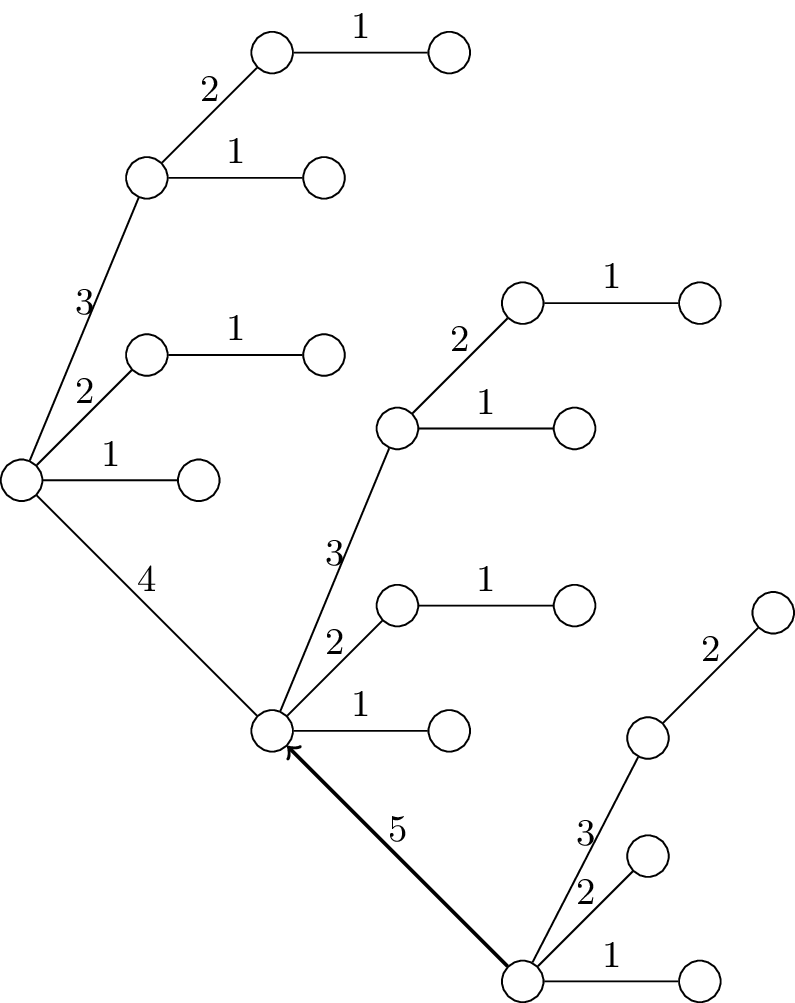Description
The code is a TikZ picture of a tree with three levels. The tree has four nodes on the first level, eight nodes on the second level, and eight nodes on the third level.
The code first sets up the style for a node named "near start abs," which shifts the node to the right by 1cm. It then loads the "positioning" TikZ library, which allows nodes to be positioned relative to other nodes.
The first level of the tree is created by creating four circles using the \node command. These circles are labeled r, r1a, r2a, and r3a. The first circle is placed at the center of the picture, while the other circles are placed relative to r using the "right of" and "above right of" options. The "minimum size" option is used to set the size of each circle.
The second level of the tree is created in a similar way. Each node on this level is positioned relative to a node on the first level, and the "minimum size" option is used to set the size of each node.
The third level of the tree is also created using the same method. The only difference is that one of the nodes on the third level is connected to a node on the first level using a line.
Finally, the code connects the nodes with lines using the \draw command. The label for each line is set using the "node[above]" option, and the line is drawn using the "++" syntax, which specifies a relative position.
Keywords
tikzpicture, node, draw, rectangle, below, left, right, above, fill, text, scale, coordinate.
Source Code

\documentclass[tikz]{standalone}
\tikzset{near start abs/.style={xshift=1cm}}
\usetikzlibrary{positioning}
\begin{document}
\begin{tikzpicture}[node distance=1.5cm]
% place nodes
\node[circle,draw=black, fill=white, inner sep=0pt,minimum size=10pt] (r) {};
\node[circle,draw=black, fill=white, inner sep=0pt,right of=r, minimum size=10pt] (r1a) {};
\node[circle,draw=black, fill=white, inner sep=0pt,above right of=r, minimum size=10pt] (r2a) {};
\node[circle,draw=black, fill=white, inner sep=0pt,right of=r2a, minimum size=10pt] (r2b) {};
\node[circle,draw=black, fill=white, inner sep=0pt,above of=r2a, minimum size=10pt] (r3a) {};
\node[circle,draw=black, fill=white, inner sep=0pt,right of=r3a, minimum size=10pt] (r3b) {};
\node[circle,draw=black, fill=white, inner sep=0pt,above right of=r3a, minimum size=10pt] (r4a) {};
\node[circle,draw=black, fill=white, inner sep=0pt,right of=r4a, minimum size=10pt] (r4b) {};
% Extension from 7 nodes
% Blank node
\node[inner sep=0pt,below right of=r, minimum size=10pt] (t) {};
\node[circle,draw=black, fill=white, inner sep=0pt,below right of=t, minimum size=10pt] (t1) {};
\node[circle,draw=black, fill=white, inner sep=0pt,right of=t1, minimum size=10pt] (t1a) {};
\node[circle,draw=black, fill=white, inner sep=0pt,above right of=t1, minimum size=10pt] (t2a) {};
\node[circle,draw=black, fill=white, inner sep=0pt,right of=t2a, minimum size=10pt] (t2b) {};
\node[circle,draw=black, fill=white, inner sep=0pt,above of=t2a, minimum size=10pt] (t3a) {};
\node[circle,draw=black, fill=white, inner sep=0pt,right of=t3a, minimum size=10pt] (t3b) {};
\node[circle,draw=black, fill=white, inner sep=0pt,above right of=t3a, minimum size=10pt] (t4a) {};
\node[circle,draw=black, fill=white, inner sep=0pt,right of=t4a, minimum size=10pt] (t4b) {};
% Third group
\node[inner sep=0pt,below right of=t1, minimum size=10pt] (v) {};
\node[circle,draw=black, fill=white, inner sep=0pt,below right of=v, minimum size=10pt] (v1) {};
\node[circle,draw=black, fill=white, inner sep=0pt,right of=v1, minimum size=10pt] (v1a) {};
\node[circle,draw=black, fill=white, inner sep=0pt,above right of=v1, minimum size=10pt] (v2a) {};
\node[circle,draw=black, fill=white, inner sep=0pt,above right of=v1,yshift=1cm, minimum size=10pt] (v3a) {};
\node[circle,draw=black, fill=white, inner sep=0pt,above right of=v3a, minimum size=10pt] (v4a) {};
\draw (r) -- node[above] {\small{1}} ++(r1a);
\draw (r) -- node[above] {\small{2}} ++(r2a);
\draw (r3a) -- node[above] {\small{3}} ++(r);
\draw (r2a) -- node[above] {\small{1}} ++(r2b);
\draw (r3a) -- node[above] {\small{1}} ++(r3b);
\draw (r3a) -- node[above] {\small{2}} ++(r4a);
\draw (r4a) -- node[above] {\small{1}} ++(r4b);
% Second nodes
\draw (t1) -- node[above] {\small{1}} ++(t1a);
\draw (t1) -- node[above] {\small{2}} ++(t2a);
\draw (t3a) -- node[above] {\small{3}} ++(t1);
\draw (t2a) -- node[above] {\small{1}} ++(t2b);
\draw (t3a) -- node[above] {\small{1}} ++(t3b);
\draw (t3a) -- node[above] {\small{2}} ++(t4a);
\draw (t4a) -- node[above] {\small{1}} ++(t4b);
% Third node
\draw (v1) -- node[above] {\small{1}} ++(v1a);
\draw (v1) -- node[above] {\small{2}} ++(v2a);
\draw (v3a) -- node[above] {\small{3}} ++(v1);
\draw (v4a) -- node[above] {\small{2}} ++(v3a);
\draw (r) -- node[above] {\small{4}} ++(t1);
\draw[->, thick] (v1) -- node[above] {\small{5}} ++(t1);
% \draw (t1) -- node[above] {\small{3}} ++(t2a);
% \draw (t1) -- node[above] {\small{2}} ++(t2b);
\end{tikzpicture}
\end{document}